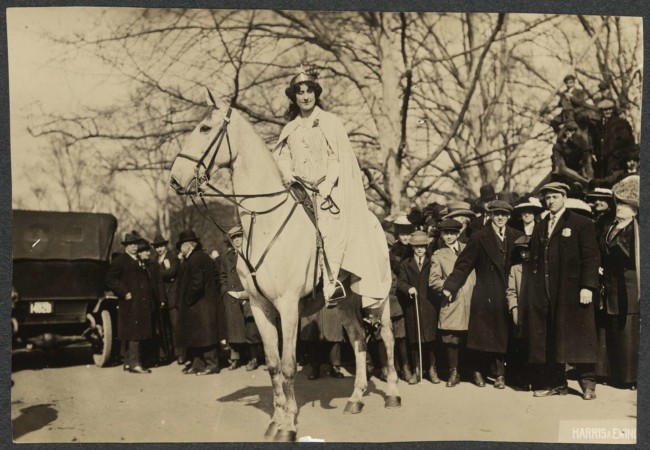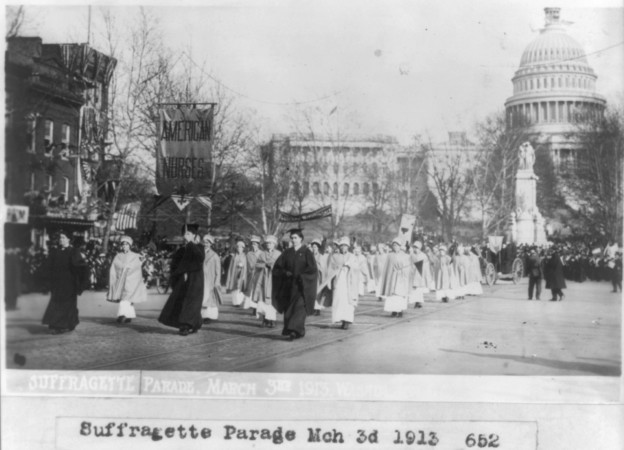Organizing Sweeps the Nation
Between 1890 and 1910, women in Connecticut won the right to vote for school officials and on library issues. They began serving in select state and local offices, as school trustees, public librarians, police matrons, notaries public, and assistant town clerks. But, like most American women, they still could not vote in the vast majority of local or state elections, or in presidential elections.
To keep the movement going, suffragists in the early 1900s adopted radical new tactics. Marching for the vote and other “unladylike” methods were brought to the United States by Alice Paul, among others, who learned from British suffragists. Paul introduced these new tactics at the Woman Suffrage Parade of 1913 in Washington, D.C. The parade featured suffragist and lawyer Inez Milholland on a white horse, followed by over 8,000 participants, 24 floats, and 9 bands. The marchers faced opposition, jeering, and physical assault from largely male crowds that had gathered for Woodrow Wilson’s presidential inauguration, and received little help from a complicit police force. Nevertheless the march made national headlines and inspired women across the country.
The first suffrage parade in Connecticut was in Hartford on May 2, 1914, one of many held across the nation that day. Over 2,000 women dressed in white marched in the parade, which featured a “Taxation without Representation is Tyranny” banner, a young woman dressed as Joan of Arc, floats symbolizing child labor, tenements, and bad factory conditions, and a line of cars representing states where women could vote. The whole procession was followed up by an outmoded ox-cart with a sign reading “Connecticut trying to catch up.”
English methods revitalized the movement, but also caused controversy and new divisions. Paul and her followers invaded state and national representatives’ offices, went on hunger strikes, and eventually picketed the White House. By 1914 they were ejected from the National American Woman Suffrage Association, ultimately forming a new organization called the National Woman’s Association, which used radical tactics to push for the immediate adoption of a federal amendment. Meanwhile National American Woman Suffrage Association members continued to parade, rejected more aggressive methods, and initially maintained their focus on state solutions rather than a constitutional amendment.
World War I saw a major shift in strategies. This was an opportunity for women to prove they were capable of full citizenship and prepared for the vote. National American Woman Suffrage Association women and state branches, including the Connecticut Woman Suffrage Association, helped the war effort by fundraising, farming, preserving food, and nursing. They scaled back on even the milder English tactics, signaling their willingness to sacrifice for the nation in its time of need and to prove just how deserving of the vote they really were. Women made themselves so essential that the Connecticut association publicly claimed it was “treason to say that womens’ place is in the home.”
Paul’s National Woman’s Association, on the other hand, stuck to more aggressive measures. The pressure of Paul’s demonstrations and the negative publicity of jailed suffragists force-fed in prison – alongside popular recognition of women’s contributions to the war effort – led President Wilson to finally announce his support of a constitutional amendment for women’s suffrage in a speech before Congress. A few months later, in June 1919, Congress passed the 19th Amendment and sent it to the states for ratification, after which it was formally adopted on August 26, 1920. Women across the country voted in their first presidential election three months later on November 2, 1920.


